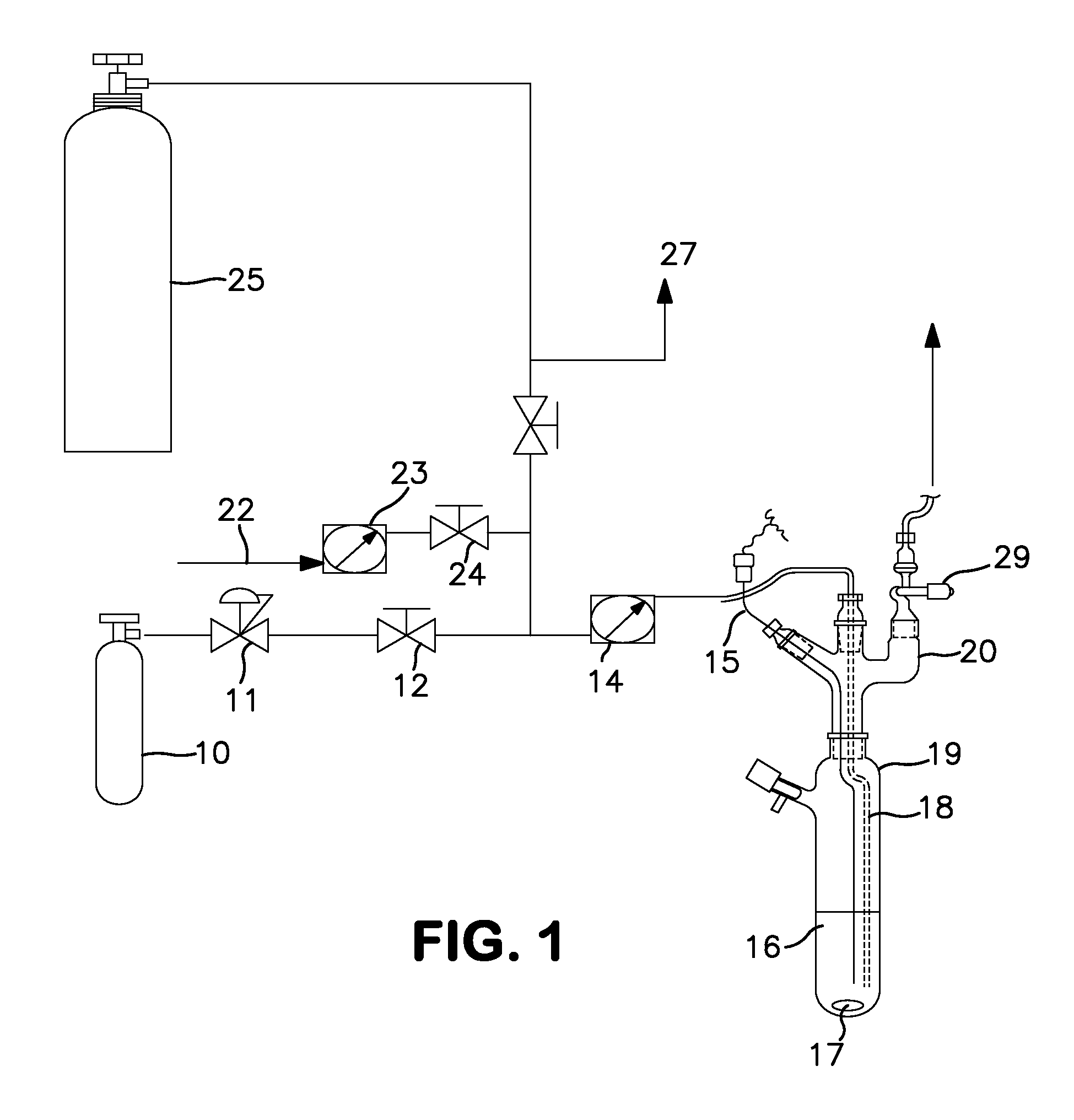Apparatus and method for the condensed phase production of trisilylamine
a technology of condensed phase and trisilylamine, which is applied in the field of batch method for synthesizing silylamine, can solve the problems of limited batch size, inability to decompose, and small vessel size, and achieve favorable condensed-phase disilylamine intermediate reaction kinetics, promote liquefaction of mcs, and enhance tsa formation over a relatively short period of tim
- Summary
- Abstract
- Description
- Claims
- Application Information
AI Technical Summary
Benefits of technology
Problems solved by technology
Method used
Image
Examples
example 1
Synthesis Using a Schlenk Tube Reactor FIG. 1
[0046]A 250 mL Schlenk tube 19, fitted with an internal thermocouple probe (⅛″ o.d. stainless steel, T-type) 15, ⅛″ o.d. stainless steel ammonia sparge tube 18, and ¼″ o.d. HDPE tubing was charged with 100 mL of anhydrous anisole under nitrogen. The tube was placed in a temperature controlled bath. The end of the sparge tube was raised above the liquid level and the solvent was cooled to −35° C. (freezing point of anisole is −37° C.). The head space nitrogen was then removed in vacuo from the Schlenk tube, with agitation of the solvent with magnetic stir bar 17, to a final pressure of less than 1 ton. A 7.8 L (internal volume) carbon steel cylinder, which contained 900 ton pressure MCS (26.4 g, 397 mmoles) 25 was then condensed (through tube 27) into the adjacent U-trap (not shown) with the reaction tube closed. The valve adapter (see FIG. 1) 29 on the Schlenk tube was then opened and the MCS in the U-trap was allowed to warm to ambient t...
example 2
[0048]Synthesis using a 600 cc Parr reactor (FIG. 2). A 600 cc Parr 100 reactor was charged with 200 mL of anhydrous anisole 106 under nitrogen. (The reaction apparatus is shown in FIG. 2). The reactor was then cooled in an ice bath (not shown) and the nitrogen removed in vacuo. Monochlorosilane (65.7 g, 987 mmol., 200 mole % excess) was charged into the reactor through a dip tube 101. The internal pressure of the reactor was approximately 900 Torr at 0° C. The dip tube was then purged with nitrogen delivered through flow meter 111 and tube 107 to clear the line and dip tube. Anhydrous ammonia was immediately added to the reactor through the dip tube. The reactor was stirred with a stirring rod 102 throughout the entire reagent loading and reaction time at a rate of 250 rpm. The temperature and pressure was monitored via an internal K-type thermocouple 103 and a 0-60 psig pressure gauge 104. Anhydrous ammonia (7.5 g, 440 mmol.) was added to the reactor at a rate of 140 mg / min. over ...
examples 8 to 13
Summary Examples 8 to 13
[0062]TSA was synthesized in a 4 L Autoclave stirred-tank reactor with anisole as the solvent media. A total of six runs were conducted with varying target reaction temperatures, excess MCS amounts and the solvent to NH3 ratio. Based on the results of the runs the following reaction conditions are recommended:
[0063]Reaction Temperature equals about 20° C. to about 60° C.
[0064]Excess MCS amount equals about 25% to about 40% excess to theoretical MCS amount on a mole to mole basis.
[0065]TSA results are reported as a percent of theoretical yield.
[0066]Solvent to NH3 mass ratio equals about 25:1 to about 30:1. Solvent to NH3 mass ration will be expressed as a whole number throughout this specification.
[0067]In the six runs, vacuum stripping was done from the reactor (typically at 10 to 18 psia) to a receiver in a LN2 dewar. The stripping rate was about 2.2 gm / min through a ¼ inch line and standard cylinder valve opening. The crude product was collected in the rec...
PUM
 Login to View More
Login to View More Abstract
Description
Claims
Application Information
 Login to View More
Login to View More - R&D
- Intellectual Property
- Life Sciences
- Materials
- Tech Scout
- Unparalleled Data Quality
- Higher Quality Content
- 60% Fewer Hallucinations
Browse by: Latest US Patents, China's latest patents, Technical Efficacy Thesaurus, Application Domain, Technology Topic, Popular Technical Reports.
© 2025 PatSnap. All rights reserved.Legal|Privacy policy|Modern Slavery Act Transparency Statement|Sitemap|About US| Contact US: help@patsnap.com



